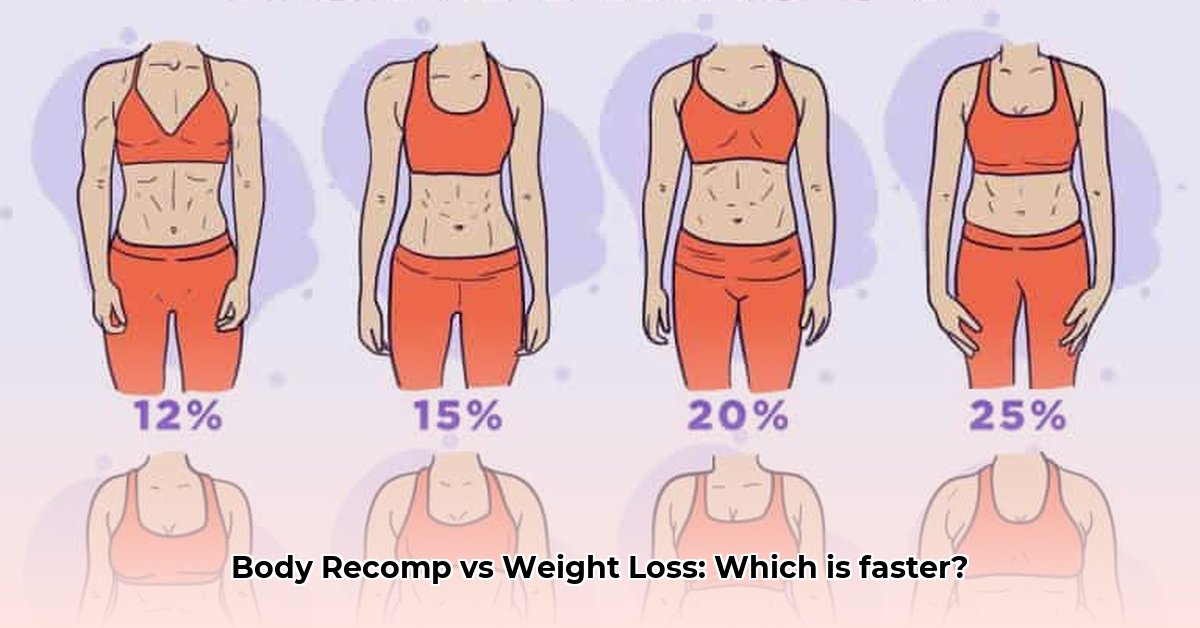
Want a better body but unsure how to get there? Many focus solely on weight loss, but body recomposition offers a different path. Both aim for a fitter you, but their methods differ significantly. This guide clarifies the distinctions between weight loss and body recomposition, helping you choose the best approach and achieve your goals faster. We'll cover practical strategies, adherence tips, and long-term plans for your body transformation.
Understanding the Basics: Weight Loss vs. Body Recomp
Weight loss simply means reducing your overall body mass. You might lose fat, but you could also lose muscle. Body recomposition, however, is about simultaneously decreasing body fat and increasing muscle mass. It’s about reshaping your physique, building a leaner, stronger you. Isn't that a more appealing goal than just a lower number on the scale?
Nutrition Strategies: Fueling Your Transformation
Both require smart eating, but the strategies diverge. Weight loss prioritizes a calorie deficit—burning more calories than consumed. This involves reducing intake, increasing activity, or both.
Body recomposition also uses a calorie deficit, but a smaller one (200-400 calories less than maintenance). Why? Because you need energy for muscle growth. A higher protein intake (1.4 to 2.2 grams of protein per kilogram of body weight) is crucial for preserving and building muscle while losing fat. Think of it like building a house—you need materials (protein) to construct (muscle)!
Workout Regimens: Exercise for Different Goals
Exercise is vital for both, but the types differ. Weight loss often emphasizes cardio (running, swimming, etc.) to burn calories. Body recomposition, however, prioritizes strength training (weightlifting) to build muscle mass. More muscle means a faster metabolism, burning more calories at rest. While cardio remains beneficial, it's secondary to resistance training in body recomposition. Building the muscle (strength training) comes before defining it (cardio).
Tracking Your Progress: Beyond the Scale
Don't solely rely on the scale, especially with body recomposition. Muscle weighs more than fat, so you might see a slight weight increase while losing fat and gaining muscle. Use multiple metrics:
- Body measurements: Track waist, hip, etc., to monitor fat loss.
- Progress photos: Visually assess changes in muscle definition and body shape.
- Clothing fit: Do your clothes feel looser? This is a great indicator.
- How you feel: Are you stronger and more energetic? These are crucial indicators of success.
Choosing the Right Path: What's Best for You?
The best approach depends on your goals and preferences. Rapid weight loss might suit some, but it may not be sustainable and could lead to muscle loss. Body recomposition, while generally slower, offers more sustainable, long-term health benefits – building muscle, boosting metabolism, and improving overall fitness. It results in a toned and shapely physique, building a stronger foundation for long-term health.
Body Recomp vs. Weight Loss: A Side-by-Side Comparison
| Feature | Weight Loss | Body Recomposition |
|---|---|---|
| Primary Goal | Reduce overall body weight | Simultaneously increase muscle, decrease fat |
| Calorie Intake | Significant calorie deficit | Moderate calorie deficit (200-400 less) |
| Protein Intake | Moderate | High (1.4-2.2 grams per kg of body weight) |
| Exercise Focus | Primarily cardio | Primarily strength training, supplemented by cardio |
| Timeframe | Varies, can be relatively quick | Generally slower, noticeable changes in 4-12 weeks |
| Sustainability | Can be challenging to maintain | Often more sustainable in the long run |
| Measurement Focus | Primarily weight | Weight, body measurements, photos, how clothes fit |
Important Considerations
Consistency is vital. Regardless of your choice, dedication and patience are key. Be realistic about your goals and celebrate milestones. The best approach is one you can maintain. Consult a healthcare professional or certified personal trainer for personalized advice. Individual results vary.
How to Maintain Muscle While Losing Weight Safely
Key Takeaways:
- Maintaining muscle during weight loss requires strategy.
- A moderate calorie deficit (300-500 calories) is key for sustainable fat loss.
- Sufficient protein intake (at least 1.5 grams per kilogram of body weight) preserves muscle mass.
- Regular strength training (at least twice a week) stimulates muscle growth and boosts metabolism.
- Prioritizing whole, unprocessed foods enhances satiety and supports overall health.
Understanding the Balancing Act: Body Recomposition vs. Weight Loss
Many struggle to maintain muscle while losing weight safely. This isn't about choosing one over the other; it's about strategies for achieving both—body recomposition. Weight loss creates a calorie deficit. Body recomposition goes further, aiming to lose fat and build or maintain muscle. It's slower but yields a better physique.
The Cornerstones of Successful Fat Loss and Muscle Preservation
Success rests on three pillars:
- Strategic Calorie Restriction: A drastic reduction leads to muscle loss. A moderate deficit (300-500 calories) is far more effective.
- Prioritizing Protein: Aim for at least 1.5 grams of protein per kilogram of body weight daily. Distribute intake throughout the day.
- Resistance Training: Strength training (twice weekly, focusing on compound exercises) is essential for preserving and building muscle.
Nutritional Strategies for Success
Prioritize whole, unprocessed foods (lean proteins, complex carbs, healthy fats). Limit processed foods, sugary drinks, and unhealthy fats.
Addressing Potential Risks
Excessive calorie restriction can lead to muscle loss and nutrient deficiencies. Insufficient protein hinders muscle preservation. Lack of strength training eliminates the stimulus for muscle growth.